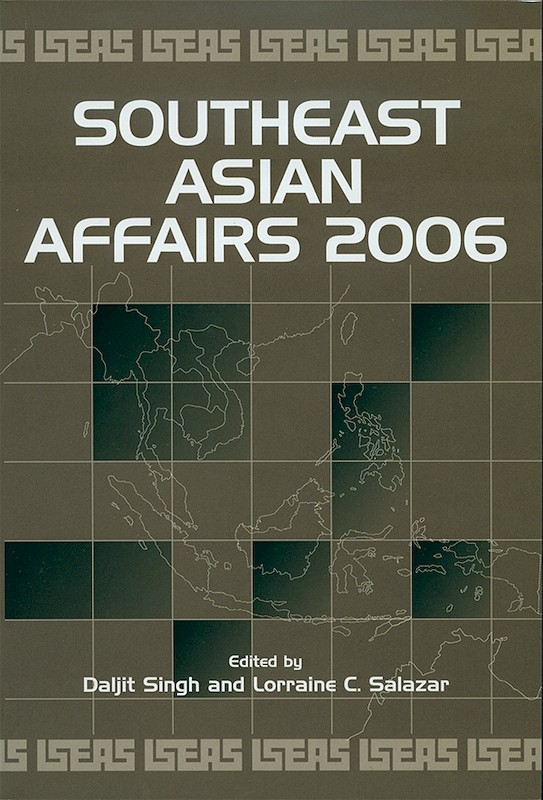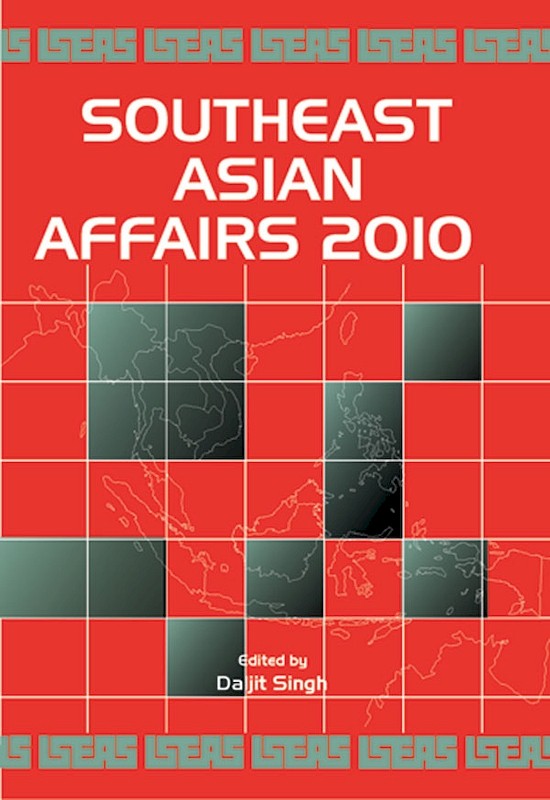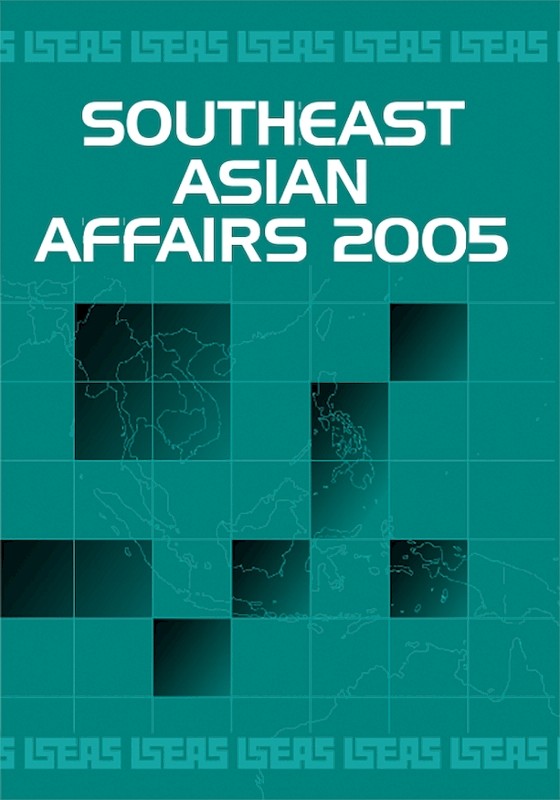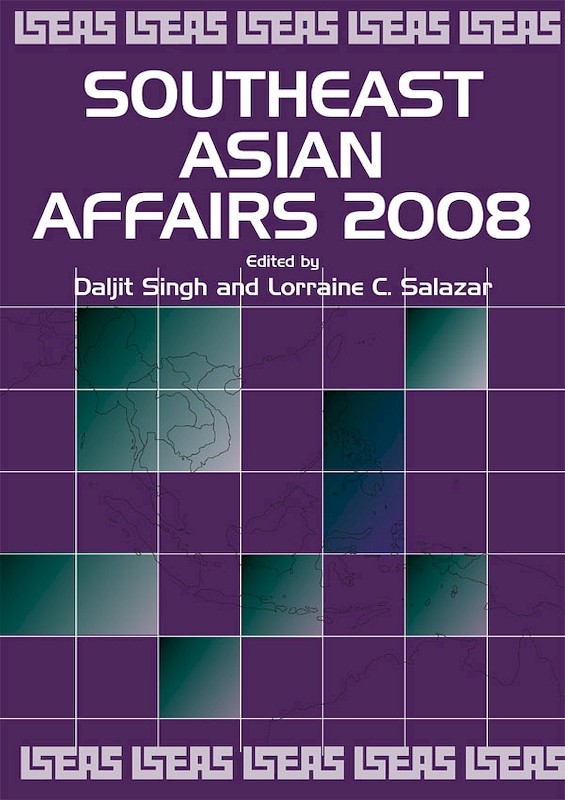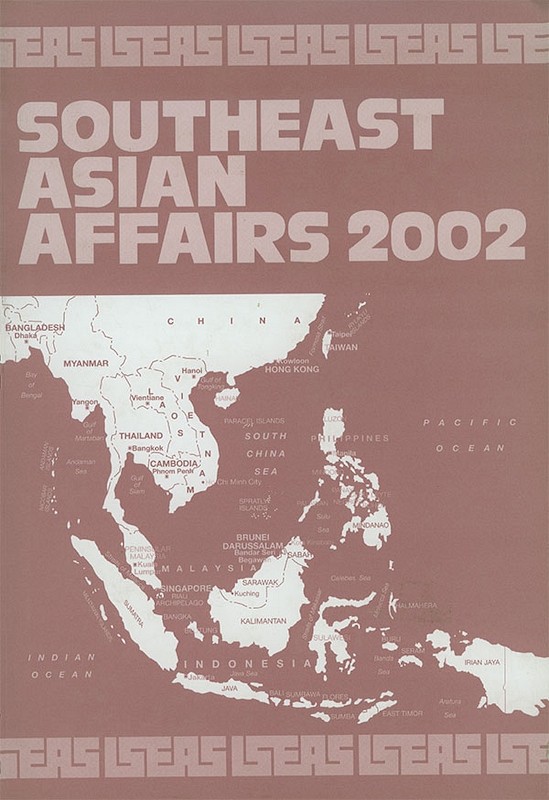Southeast Asian Affairs 2007

Date of publication:
2007
Number of pages:
412
Code:
SEAA7
Reviews
"Tracking people and events is necessary to political understanding and research. For a foreign country, this may be undertaken by closely following local media or by reading summaries. These latter, for Southeast Asia, range from the skeletal entries in general yearbooks or almanacs to the more authoritative and interpretive but anonymous reports from the Economist Intelligence Unit for business, the annual one-article-per-country scholarly compilations in the January-February issue of Asian Survey, or--lengthiest and most thorough--this annual compilation from the prestigious Singapore think tank Institute of Southeast Asian Studies" (Choice).
About the publication
Southeast Asian Affairs 2007 provides an informed and readable analysis of the events and developments in the region in 2006. In the regional section of this volume, the first two articles provide the political and economic overview of Southeast Asia, while the third and fourth examine the character of political development in the region. Eleven country reviews as well as five special theme articles follow, delving into domestic political, economic, security, and social developments during 2006 and their implications for countries in the region and beyond.
Contents
-
Southeast Asian Affairs 2007
-
Preliminary pages
- THE REGION
-
Southeast Asia in 2006: Djà vu All Over Again, by Donald E Weatherbee, author see abstractEvents in 2006 demonstrated that while threats to national and regional security defined in traditional categories may be less imminent for the ASEAN nations, human security measured in terms of civil and human rights remains at risk throughout Southeast Asia. With the exception of Indonesia, the political fabrics of the regions unconsolidated democracies continued to fray or, in the case of Thailand, even rip. The pattern of national deviations from the putative democratic norms embraced in the concept of an ASEAN Community was paralleled in the economic sphere. Rather than ASEAN integration, the Southeast Asian noodle bowl of bilateralism and beggar-thy-neighbor policies of self-interest continues to undermine solidarity. The net result is that the gap between ASEANs aspiring goal of regional community and national interests is widening.
-
The Regional Economies: A Year of Growth, Stability, and Resilience, by Manu Bhaskaran, author see abstractFor Southeast Asian economies, the year 2006 was marked by vibrant growth, improving economic stability, and an unexpected degree of resilience to external and domestic shocks. Economic growth was driven significantly by external demand while domestic demand played a secondary role in promoting growth. ASEAN economies have seen significant improvements in their external positions as shown by the rise in current account/GDP ratios. Foreign reserves have surged hence strengthening ASEANs resilience against a sudden capital outflow out of the region. In terms of internal stability, inflationary pressures remained fairly well contained in 2006 due to aggressive tightening of monetary policy. Major restructuring after the 1997 Asian Financial Crisis has cleansed ASEAN economies of many structural weaknesses and improved their resilience significantly. Overall, the year 2006 was a year in which the Southeast Asian economies proved to be resilient in overcoming the challenges in the global environment while also absorbing a number of domestic shocks.
-
The Southeast Asian Development Model: Non-liberal Democracy with Market Accountability, by David Martin Jones, author see abstractIn the post Asian Financial Crisis environment, the ruling elites of Southeast Asian states had to adjust to an increasingly financially interconnected global order. This condition rendered developing and developed Southeast Asia more, rather than less, dependent upon, the vagaries of the fast world of stock exchanges that never sleep. Since 1997 we can identify Southeast Asian states, with varying degrees of success, adjusting the shape of the state to the testing requirements of this new environment. By 2006, a Southeast Asian model that demonstrates a cultural preference for an administrative rather than a liberal, pluralist, state system as the basis for managing the effects of global capital may be discerned. This non-liberal model, however, cannot be purely autocratic, autarkic, or unaccountable. It is instead a technocratic model that embraces flexible and pragmatic leadership by a dominant party, subject to a mechanism of regular elections and a degree of economic transparency. This article considers, via an examination of recent political and economic developments in Southeast Asia, the lineaments of this sui generis model.
-
Petroleum and Mining in Southeast Asia: Managing the Environmental and Social Impacts, by Andrew Symon, author see abstractA host of new upstream oil and gas and mining projects is underway in Southeast Asia as a result of increased demand from both within the region and worldwide. This presents governments with an array of issues. Policy concerns go beyond immediate industry matters and may encompass macro economic, budgetary, tax, and exchange rate issues as well as environmental protection and land access and ownership questions. Crucially, given that most projects are in areas distant from the urban centres, they also must address relations between the central and local governments and regional development planning. Especially critical is the impact of production on local communities and the surrounding environment. Both governments and companies must address this. For governments, poisoned relations with local regions may take many years to heal. At worst, they could encourage separatist movements harnessing this grudge against the centre. For companies, at stake is the long run success of the particular operation, and, increasingly, other activities elsewhere in the world. A bad record in one country may harm a companys prospects elsewhere, through, for example, its ability to finance other projects from major banks, themselves conscious of risks to their international reputation.
- BRUNEI DARUSSALAM
-
Brunei Darussalam: Towards a New Era, by Hj Mohd Yusop Hj Damit, author see abstractThe year in review represented a coming of age for Brunei Darussalam in several respects. Politically, economically, socially, and educationally, Brunei was moving fast towards becoming a vibrant nation in Southeast Asia. His Majesty the Sultan himself reached a landmark by turning 60, and the birthday event was rightfully celebrated in grand style countrywide. Moves were afoot to get the defunct Legislative Council functioning with limited electoral representation forthcoming for the people. This brings the Sultanate close to her Southeast Asian neighbours in political equality and helps Brunei shed her antiquarian and anachronistic image as a moribund monarchy. Struggling to break away from its oil-derived income statues, ideas and actions have matured to develop a diversified economy and multiply opportunities for an increasingly educated working class. Internationally, Bruneis standing went up further by closer cooperation with its neighbours and the countries beyond the region.
- CAMBODIA
-
Cambodia: The Endgame of Politics?, by Milton Osborne, author see abstractDuring 2006 Cambodian politics have been marked by the continuing consolidation of Prime Minister Hun Sens power over the state. Conversely, the year has seen FUNCINPECs leader, Prince Norodom Ranariddhs loss of the leadership of his party, which now seems ever more closely wedded to Hun Sens CPP. While the year began with Hun Sens apparent softening of his attitudes towards his more outspoke opponents, and in particular Sam Rainsy, it has ended with him firmly in control and those opposed to him no closer to translating their criticisms into change within the countrys body politic. Progress towards the establishment of a tribunal to try senior members of the Khmer Rouge remains glacial. More positively, Cambodias relations with its immediate neighbours, and additionally and importantly with China, have been marked by amity. Although requiring continuing assistance from international donors, Cambodias economy is healthy and seems set to be boosted by the discovery of off-shore oil reserves in its maritime zones.
- INDONESIA
-
Indonesia: Democracy First, Good Governance Later, by Douglas Ramage, author see abstractThe article examines the impressive progress made in many areas of Indonesias democratic consolidation since the end of the Soeharto era, including the retreat of the armed forces from most aspects of national life, sound macroeconomic management, and progress in the fight against terrorism. In these developments, the key role of the President Susilo Bambang Yudhoyonos competent leadership is highlighted. The year 2006 is arguably a watershed year in which nationalism, tolerance, and Pancasila made a comeback in Indonesia. Nevertheless, while the government was doing well in dealing with the countrys political and security problems, governance shortcomings remained and the investment climate was still poor. Important policy reforms to improve the investment climate, and develop infrastructure and the financial sector, were stalled. Judicial and legal reform was uneven, while meaningful reform of the inefficient civil service had barely begun. Despite this challenges, Indonesia on the whole, was on the right track under an able president.
- LAOS
-
Laos: Politics in a Single-party State, by Martin Stuart-Fox, author see abstractPolitics is not of much public concern in a single-party state like Laos. But in 2006, the Lao Peoples Revolutionary Party held its five-yearly congress. This was followed by national elections and the installation of a new government. Expectations for a change of leadership and policy direction were dashed, however, when only Party and state president General Khamtay Siphandone stepped down, to be replaced by his close comrade, Lt-Gen Choummaly Sayasone. All the other aging military members of the Politburo remain in place. A new prime minister, Bouasone Bouphavanh, was appointed, but it is doubtful if he has the power, even if he has the will, to introduce needed reforms. In the meantime, Laos continues to face problems of growing disparities of wealth, growing corruption, and low standards of education and health care to name a few. But hydropower, mining, and tourism do hold out some prospects for the economy.
- MALAYSIA
-
Malaysia: Abdullah Does It His Own Vague Way, by Ooi Kee Beng, author see abstractPrime Minister Abdullah main goal over the coming months is to maintain public confidence in his reforms and his administration's economic acumen. His unconvincing performance on the political stage, often more vague than elegant, along with his unwillingness to explain his methods continue to generate discontent and disenchantment. The fight against corruption and wastage were pushed to the backseat by aggravated inter-ethnic and inter-faith relations. The negative effects of Mahathir Mohamed's 22 years in power have now become undeniable, and put Abdullah's ability to the test. Mahathir started in June 2006 to vent his frustration over government policies by attacking Abdullah Badawi himself. The constitutional right to worship freely also became a heated issue, alongside debates about affirmative action programmes and the methods used to monitor them. Unlike the home front, foreign relations did not provide much drama during the year. Economically, signals have been mixed and worries about the long term are steadily rising.
-
PAS Leadership: New Faces and Old Constraints, by Liew Chin Tong, author see abstractMalaysias key opposition Islamist party, Parti Islam Se-Malaysia (PAS), elected a set of younger and more sophisticated leaders at the Partys Congress in June 2005 with the promise of a generation shift and a re-branding of the partys image. The new leadership attempts to make PAS more appealing to the multiethnic mainstream Malaysian society by quietly discarding some sacred hard-line goals, such as the establishing of an Islamic State. Apparently, PASs tactic is to move towards the ideological centre in order to increase its chances of winning votes. But it runs the risk of losing the tail, constituted by selfless and fervent hardliners, who support the more or less permanent opposition party based on principles that they cherish, knowing full well that they would not be rewarded financially. This article analyses the structural constraints under which PAS operates as well as the challenges the new party leadership faces.
- MYANMAR
-
Myanmar: The Future Takes Form But Little Change in Sight, by Morten B. Pedersen, author see abstractAfter nearly 20 years in government office, Myanmar's military rulers are preparing to hand over power to a civilian successor regime under a new constitution. Yet, they are doing so at their own will and according to their own designs. While opposition continues, both inside Myanmar and abroad, the balance of power remains heavily tilted in favour of the military, which in 2006 further shored up the political and economic basis for its continued control of the country. Opportunities for gradual reform exist. But much depends on the courage of future generations, on all sides, who will have to take a chance on peace.
-
Myanmar's Foreign Trade under Military Rule: Patterns and Recent Trends, by Tin Maung Maung Than, author see abstractWhen the military took over control in September 1988, market-oriented reforms were quickly introduced after abolishing the socialist economic system. Foreign trade that had been the sole prerogative of the state was liberalized to allow private participation and an open door policy towards foreign direct investment (FDI) and foreign trading firms was instituted in 1989. This led to a revival of foreign trade as a significant driver of economic growth, a major source of fungible hard currency and a provider of revenue for the state. The private sector quickly realized its potential for quick returns and rapid expansion and trading enterprises blossomed in the early 1990s with the number of registered export/import companies increasing from none in 1988 to 2,813 in April 2001 and to 19,494 in June 2005. Since the Myanmar currency is not convertible, exports became the sole vehicle of the private sector for obtaining scarce foreign exchange required not only to import consumer goods but also to obtain materials and equipment for the services and manufacturing sectors as well. By the fiscal year 2005-06 the value of foreign trade reached US$ 5.5 billion -- six times its volume twenty years ago. The paper delineates the establishment of new institutions and government regulations in the foreign trade sector and examines the patterns and trends of Myanmars foreign trade in recent years, concluding that more extensive reforms are needed to realize the full potential of foreign trade as an engine of growth for the Myanmar economy.
- THE PHILIPPINES
-
The Philippines: In the Eye of the Political Storm, by Frank Cibulka, author see abstractThe chapter explores the continuing political crisis in the Philippines, which has engulfed the administration of President Gloria Macapagal-Arroyo since 2004. It analyses the deeper structural causes of the countrys political instability and examines the main political events of the year, including the continuing attempts to impeach Arroyo, military interventionism, declaration of a state of emergency, and the failure of the constitutional reform process. The status of the countrys multiple insurgencies is also discussed, with particular attention paid to the war against the Abu Sayaf group in the south of the country. The chronic political instability in the Philippines is contrasted against the improving economy, although the healthier fiscal status, continuing GDP growth, and increasing remittances from overseas workers belie the endemic poverty in the archipelago. Finally, the countrys foreign relations are discussed with particular emphasis upon the complex and contradictory relationship with the United States.
-
The Philippines: Political Parties and Corruption, by Nathan Gilbert Quimpo, author
- SINGAPORE
-
Singapore: Campaigning for the Future, by Ho Khai Leong, author see abstractThe year 2006 was an eventful one for Singapore. It witnessed several important events in the Republic, all of which have long-term political and economic significance. First, Singapore held its sixth election since independence, the first general elections led by Lee Hsien Loong since becoming Prime Minister in August 2004 and Secretary General of the Peoples Action Party (PAP). Second, Singapore hosted the Annual Meetings of the Boards of Governors of the International Monetary Fund (IMF) and the World Bank (WB) Group, amidst civil society organizations protest and international bad press coverage on the Singapore governments refusal to admit a number of them. Third, the Government-linked Temaseks investments in Shin Corp, the family business of Thailands former Prime Minister Thaksin Shinawatra, who was deposed in a military coup in September, weathered legal problems and continued to develop into a policy lesson in government-business relations for both of the countries involved. Smoke haze from Indonesias forests covered most of the country in October, propelling once again an urgent call by ASEAN to help Indonesia fight the forest fires. On the economic front, Singapores economy picked up steam in the middle of the year, and experienced a relatively robust growth rate of 7.7 per cent.
- THAILAND
-
Thailand: A Reckoning with History Begins, by Michael J Montesano, author see abstractThe first nine months of 2006 saw Thailands elected Prime Minister Thaksin Shinawatra survive escalating extra-constitutional efforts to remove him from power. Not only disgust at Thaksins authoritarian style and blatant use of his office to pursue personal interests but also the fundamental threat that he seemed to pose to Thailands half-century-old, palace-centered political order motivated these efforts. Thaksins ability to deny that campaign its goal of his ouster resulted finally in the coup dtat of 19 September. The final three months of the year saw the military-backed royalist regime installed by the coup-makers struggle both to take revenge on Thaksin and to begin construction of a less threatening, more manageable political order. Prospects for success in this latter task were poor. On the last day of the year, a series of bombings in Bangkok suggested that the critical reckoning with its recent history that 2006 forced upon Thailand had only just begun.
-
Learning from the 19 September Coup: Advancing Thai-style Democracy?, by Surin Maisrikrod, author see abstractThe article traces the rise of Thaksin government in 2001, the first election following the promulgation of the Peoples Constitution of 1997. Despite the new charters strong democratic provisions, Thaksin was seen as practicing democratic exceptionalism, treating with contempt western-style democratic principles of upholding a system of checks and balances, civil liberties, and political pluralism. Thaksin, even with overwhelming parliamentary majority, eventually succumbed to the loss of moral authority following allegations of corruption, cronyism, interference in accountability institutions, intervening in the military and bureaucracies, and bypassing the parliamentary process. The takeover by the military on 19 September has brought Thailand back to a bureaucratic polity. What has and has not worked for Thai democracy is the key question that peopleincluding the drafting committee of a new Constitutionis asking. In the process, a new idea about Thai-Style Democracy (TSD) has emerged. On the face of it, this TSD looks very bureaucratically-oriented. But more fundamentally, what is emerging is a serious thought about giving a legitimate political role to such key institutions such as the military and aristocracy.
- TIMOR-LESTE
-
Timor-Leste: The Harsh Reality After Independence, by Damien Kingsbury, author see abstractIn 2006, East Timors post independence hopes were dashed as the tiny country descended into internecine violence, reflecting both long-held and more recent political animosities. East Timors chronic poverty and unemployment fuelled the violence, while the United Nations had withdrawn without ensuring adequate administration was in place. Foreign troops and police restored general order, although sporadic violence continued until the end of the year. Prime Minister Mari Alkitiri was held accountable for the descent into violence and forced to resign his position. Two ministers were also sacked, while a number of officials were charged with illegally distributing weapons. Alkataris government had brought the impoverished country into economic growth, but was widely criticized for being too centralized, inflexible, and increasingly authoritarian. Alkatiris replacement, former Foreign Minister Jose Ramos-Horta, was more inclusive and popular, although still divisive. Popular President Xanana Gusmao was also implicated in the political division of East Timorese society.
- VIETNAM
-
Vietnam: The Tenth Party Congress and After, by Carlyle A. Thayer, author see abstractIn 2006, Vietnam achieved great success across virtually all fronts. In April, it held the tenth national congress of its ruling communist party amidst rising public pressure to take firm action to curb corruption and demands from within to expand the scope of inner party democracy. A major turnover in leadership occurred at the congress, and subsequently reformist leaders were appointed state president and prime minister. The political status quo was challenged by the emergence of Vietnams largest and most diverse pro-democracy movement. Vietnams economy grew at one of the fastest rates in Asia. Externally, Vietnam hosted the 14th summit of the Asia Pacific Economic Cooperation forum, gained membership in the World Trade Organization, and nomination as a non-permanent member on the United Nations Security Council. Vietnam also deftly balanced it relations with China and the United States by hosting separate visits by their defence ministers and state presidents.
-
Vietnam: Preparations for WTO Membership, by Binh Tran-Nam, author see abstractIn 2006, no single event concerning Vietnam captured the domestic and international attention like Vietnams accession to the WTO. Further international economic integration via the WTO represents both exciting and tremendous opportunities and challenges to Vietnam. This article critically discusses Vietnam's preparations for WTO membership, focusing on the legal and other domestic reforms being undertaken. The article analyses how Vietnam's accession to the WTO provides a good opportunity to accelerate the equitisation of state owned enterprises (SOEs), particularly in the banking sector. Finally, the article assesses the impact of this development on the broader Southeast Asian region. The article points out that Vietnam's WTO membership is unlikely to have a significant impact on trade and investment within the Southeast Asian region. However, as a destination for FDI flows and as a production base for re-exporting to other countries, Vietnam will become more attractive to its North East Asian countries such Japan and South Korea.

